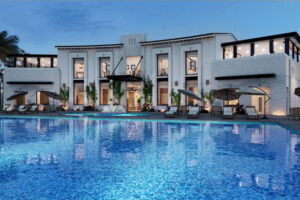How to take Photos of the Hotel Pool: Step-By-Step Guide
Michael • May 17, 2023 • 9 min read

Dive in, dear reader, into the world of hotel pool photography – a realm where every shot is a cocktail of color, light, and liquid luxury. Like a painter with a palette of chlorinated azure, you’ll learn to tell the tale of a thousand droplets, each reflecting the sun-kissed charm of a hotel’s crown jewel – its pool.
Content
No time to read? Get the essentials.
How to take Photos of the Hotel Pool:
- To take photos of a hotel pool, it’s essential to have the right equipment.
- Choose between DSLR and mirrorless cameras, wide-angle and underwater lenses. Consider lighting options like natural or artificial light.
- Plan the shoot and apply composition techniques.
- Underwater photography requires safety precautions.
- Post-production editing enhances color, sharpens details, and removes unwanted elements.
1. Essential Equipment for Pool Photography
Stepping into the arena of pool photography is akin to stepping into a gladiatorial pit, and your equipment is your arsenal. Choose wisely, dear reader, because the right tools can transform your poolside spectacle into a work of art worthy of glossy travel magazines and Instagram influencers alike. Check out our ultimate guide on hotel photography equipment to get started!
Camera: DSLR vs. Mirrorless
The debate between DSLR and mirrorless cameras is an age-old tussle, much like the clash of titans. DSLRs, with their heavyweight status and optical viewfinder, offer a certain heft and a raw, tactile shooting experience.
On the flip side, mirrorless cameras, lightweight and compact, promise an electronic viewfinder and a quiet operation that can be a boon in the hushed tranquillity of a hotel pool at dawn. Both have their merits and demerits, so choose your warrior based on your personal combat style.
Lenses: Wide-angle and Underwater
Now, let’s talk about the eyes of your camera – the lenses. A wide-angle lens, dear reader, is your ticket to grandeur. It will let you capture the expansive embrace of the pool, the inviting loungers, the verdant flora, all in one grand spectacle.
And then, there’s the underwater lens. If you wish to explore the aquatic ballet beneath the surface, an underwater lens is your snorkel, your conduit to the world below the waterline. Check out this detailed guide on how to use different angles to learn how to go about this.
Lighting Equipment: Natural light vs. Artificial light
Lighting in photography is like the sun to your solar system. Natural light, with its golden glow, can cast a magical spell on your poolside panorama. However, the capriciousness of weather may sometimes demand a dance with artificial light.
Be it softboxes or speedlights, these tools can help you manipulate light to your whims and fancies, turning dullness into a dazzling spectacle.
Underwater Photography Gear
To truly dive into pool photography, you’ll need to equip yourself with underwater gear. An underwater camera housing is as crucial as a submarine’s hull, protecting your precious camera from water’s intrusive fingers. Add to that an underwater strobe for illumination and you’re ready to capture the aquatic symphony.
Camera Stabilization: Tripods and Gimbals
Lastly, let’s not forget about stability. A tripod is your steadfast companion, holding your camera steady as you compose your shot. For dynamic shots, a gimbal offers the grace of a ballet dancer, smoothing out jerky movements and giving your photos the fluidity of a flowing stream.
There you have it, the tools of the trade. Now, go forth and conquer the watery realm of pool photography.
Readers are also interested in:
Hotel Photography Ideas
Hotel Room Photoshoot
How to take Photos of the Hotel Lobby
Benefits of professional Hotel Photography
Use Hotel Lifestyle Photography
2. Planning the Perfect Pool Shot
In the grand theatre of hotel pool photography, planning is the director that calls the shots. It’s an intricate dance of elements that, when choreographed perfectly, can create a visual symphony. So, let’s dive into the depths of planning, shall we?
Understanding the Hotel’s Branding and Style
Imagine trying to fit a round peg into a square hole – frustrating, isn’t it? The same is true in the world of photography. Each hotel exudes its own personality, its own style, and your photos should be the mirror that reflects this persona.
Are we dealing with a luxurious five-star retreat, where opulence drips from every corner? Or perhaps it’s a quaint boutique inn, where charm and warmth permeate the air?
Understanding the hotel’s branding allows you to tailor your shots to echo its ethos. It’s about capturing the soul of the hotel in your poolside portraits, about telling its story through your lens. Learn als about Luxury Resort Photography.
Scouting the Location: Time of Day, Shadows, and Lighting
The stage is set, but where does the spotlight fall? Scouting the location is akin to a reconnaissance mission. It’s about understanding the play of light and shadows throughout the day, about finding the sweet spot where the pool basks in the golden glow or where intriguing shadows create a dramatic tableau.
Does the morning sun cast a warm, inviting light on the pool, making it sparkle like a sapphire in a jeweler’s showcase? Or perhaps the setting sun paints the scene with a soft, romantic hue, turning the pool into a tranquil oasis? Knowing the best time to shoot can make the difference between a good photo and a great one. Raed also about which hotel photography mistakes to avoid.
Considering the Weather
Weather, dear reader, is the capricious diva of outdoor photography. A bright, sunny day can illuminate your poolside panorama, making the water glisten and the surroundings pop with vibrant colors. On the other hand, an overcast sky can cast a soft, diffused light, creating an ethereal, serene scene.
But what if the diva throws a tantrum? What if a sudden downpour crashes your photoshoot? Well, then it’s time to dance in the rain. Use the droplets as your props, let them create ripples in the pool, turn them into prisms that refract light into a rainbow. Embrace the unpredictability, and let it add a touch of spontaneity to your photos.
Planning, dear reader, is the roadmap to your destination. It guides your vision, sharpens your focus, and sets the stage for a captivating performance. So, plan meticulously, and let your photos sing the song of the pool, loud and clear.
3. Composition Techniques for Pool Photography
In the symphony of pool photography, composition is the rhythm that guides the melody. It’s the invisible conductor that orchestrates the visual elements into a harmonious ensemble. So let’s wade into the waters of composition, shall we?
Rule of Thirds and Symmetry
Think of the rule of thirds as the gridlines on a nautical chart, guiding you towards the sweet spot of visual balance. It’s about dividing your frame into nine equal squares and placing the main elements along these lines or at their intersections.
Imagine the sparkling pool occupying two-thirds of your frame, with the remaining third filled with azure sky or lush greenery. It creates a sense of balance, a pleasing harmony between elements.
And then we have symmetry, the ballet dancer of composition. It’s about mirroring elements across an axis, creating a visual echo that’s pleasing to the eye. The still pool reflecting the hotel façade, the loungers lined up with military precision – they create a rhythm, a synchronized dance that captivates the viewer.
Using Leading Lines
Leading lines are like the breadcrumbs in a fairy tale, guiding the viewer’s gaze through the frame. They could be the edge of the pool leading towards the hotel, the row of loungers pointing towards the pool, or even the ripples in the water, directing the gaze towards the central focus. They create a sense of depth and perspective, inviting the viewer on a visual journey through the frame.
Incorporating the Surroundings
In the world of pool photography, the pool is the star, yes. But what about the supporting cast? The surrounding elements – be it the lush flora, the towering hotel, or the quaint poolside café – all play a role in setting the scene. They provide context, a sense of place that anchors the pool in its environment. They tell a story, a narrative that goes beyond the pool, painting a complete picture of the hotel’s charm.
Focusing on Details: Water Texture, Reflections, etc.
Finally, we come to the details, the unsung heroes of photography. The texture of the water – sometimes smooth as glass, sometimes a dance of ripples – can add a tactile dimension to your photos. Reflections, on the other hand, are like visual echoes, adding a layer of depth and intrigue.
Then there are the smaller elements – the dew on a leaf by the pool, the cocktail on the poolside table, or the pattern on the pool tiles. They add a touch of intricacy, a dash of intimacy to your poolside portraits.
In the grand waltz of pool photography, composition is the choreography that guides the dance. So, tune in to its rhythm, follow its lead, and let your photos dance to the beat of visual harmony.
4. Underwater Pool Photography
Immerse yourself, dear reader, in the world beneath the surface, where light dances with water, and every bubble tells a tale. Underwater pool photography is an aquatic ballet, a choreography of elements that, when captured perfectly, can create a mesmerizing spectacle. But before we plunge into the depths, there are a few things to consider.
Safety Precautions
Like a seasoned diver, safety should be your North Star in the watery realm of underwater photography. First and foremost, ensure you’re comfortable and confident in water. Your buoyancy control should be as smooth as a maestro’s baton, letting you glide effortlessly without disturbing the pool’s tranquillity.
Ensure your gear is waterproof and securely housed to protect it from the pool’s liquid embrace. Also, be aware of your surroundings, especially if other people are sharing the pool. Never compromise on safety, for it’s the anchor that keeps your underwater adventure grounded.
Technical Considerations: Lighting, Focus, and Color Balance
The underwater world, while beautiful, comes with its own set of technical challenges. Lighting, dear reader, is a fickle companion beneath the surface. The water absorbs light, and colors can appear muted or distorted. An underwater strobe or flash can be your sun, illuminating the scene and restoring the vibrant colors of the pool and its surroundings.
Focus, like a well-trained dolphin, needs to be sharp and swift. The moving water, the floating particles, and the ever-changing light conditions can test your focusing skills. Using a small aperture can increase your depth of field, making it easier to keep your subjects in focus.
And then there’s color balance. The blue hue of the water can cast a monochromatic spell on your photos, making them look like a scene from a Smurf movie. Using a red or pink filter can help restore the natural colors, giving your photos a balanced, true-to-life appearance.
Capturing Dynamic Movement
Underwater photography is a dance of dynamics. It’s about capturing the graceful dive of a swimmer, the ballet of bubbles rising to the surface, or the flowing dance of a poolside dress submerged in water.
It’s about freezing a moment in time, about capturing the energy and movement of the underwater world. Using a fast shutter speed can help you seize these dynamic moments, turning them into a still spectacle of aquatic artistry.
So, there you have it. Underwater pool photography is about embracing the challenges and using them to your advantage. It’s about diving into the depths with the spirit of an explorer and emerging with a treasure trove of underwater wonders. So, take a deep breath, plunge in, and let the water tell its tale through your lens.
5. Post-Production Editing Techniques
Post-production editing, dear reader, is like the final act in a theatrical play, the encore that gives your performance a polished finish. It’s here that your raw images transform into refined masterpieces, ready for the grand applause.
Color Correction and Enhancement
Color correction is akin to a chameleon, adapting your photos to their best version. It adjusts the hues, tones down the overzealous blues of the pool, and enhances the subdued colors to their true potential. It’s about striking a balance, a harmony of colors that paints a realistic yet captivating picture.
Detail Sharpening
Sharpening details is like the stroke of a sculptor, chiseling out the finer nuances of your image. It highlights the texture of the water, the reflections on the pool surface, the patterns on the tiles. It’s about bringing out the intricacies, the subtle elements that add depth and dimension to your pool photos.
Removing Unwanted Elements
Finally, we come to the task of removing unwanted elements – the photo bombers of your perfect shot. It could be a stray towel on a lounger, a leaf floating in the pool, or a random pedestrian in the background. With tools like clone stamp or healing brush, you can sweep these intruders under the rug, giving your photos a clean, uncluttered look.
Post-production editing is the magic wand that turns your photos from mundane to mesmerizing. It’s about fine-tuning your symphony, about giving your performance the perfect finale. So, step into the editing room with a keen eye and a creative spirit, and let your photos sing their final, captivating song.
6. Utilizing Pool Photos Effectively
Ah, now comes the curtain call, the grand finale where your artistry meets the audience. The photographs you’ve painstakingly captured and masterfully edited are ready to step into the limelight. But how, you ask? Well, let’s dive into it.
Website Placement
Consider your website as the gallery where your masterpieces are on display. But placement, dear reader, is key. Hero images, those large, captivating photos you see when you land on a website, are perfect spots to showcase your stunning pool photos. These images set the tone, create a visual impact, and draw the visitors in.
Don’t forget the individual hotel room pages. A strategically placed pool photo can paint a holistic picture, showing the guests what they can expect beyond the room. And of course, the dedicated amenities section, where your pool photos can take the center stage, enticing visitors with the promise of a refreshing dip.
Social Media Strategies
Social media, with its vast reach and visual nature, is the perfect stage for your pool photos. Use Instagram to its full potential – regular posts, captivating stories, and even IGTV for behind-the-scenes or underwater videos. Utilize hashtags relevant to hotel photography, travel, and luxury stays to increase your visibility.
Facebook and Pinterest, with their options for albums, are great for showcasing a series of pool photos. Regular updates, themed posts like ‘Sunday Poolside’, or even photo contests for guests can boost engagement. Remember, social media is not just about showcasing, it’s about engaging.
Promotional Materials
Promotional materials are like your travelling minstrels, carrying the tales of your hotel’s charm to the world. Be it brochures, flyers, or digital newsletters, your pool photos can add a splash of excitement. Use them to highlight special offers – ‘Summer Poolside Getaway’ or ‘Spa and Swim Package’.
And let’s not forget print and digital ads. A stunning pool photo can catch the eye, draw the reader in, and pique their interest. It’s about creating a visual hook that entices potential guests to explore more.
Utilizing pool photos effectively is about strategic placement and engaging storytelling. It’s about ensuring your photos don’t just sit pretty, but work hard in promoting your hotel, engaging your audience, and ultimately, driving bookings. So, give your photos the platform they deserve, and let them weave the captivating narrative of your hotel’s charm.
7. The 5 most impressive Hotel Pools
-
San Alfonso del Mar Resort, Chile – This resort is home to the largest outdoor pool in the world, spanning a massive 20 acres. The pool is over 1 kilometer in length and contains 66 million gallons of seawater. Link
-
Citystars Sharm El Sheikh, Egypt – Citystars Sharm El Sheikh will soon be home to the largest man-made lagoon in the world, surpassing the pool at San Alfonso del Mar. Link
-
Laguna Bahía, Chile – This resort is home to the second largest pool in the world, a 3.5-acre lagoon. Link
-
Dreamworld Fun Lagoon, Pakistan – This resort boasts the fourth largest pool in the world and the largest in South Asia, at over 200,000 square feet. Link
-
Hayman Island Resort, Australia – This resort’s pool is impressive, with a total area of 165,000 square feet. It’s the largest pool in the Southern Hemisphere. Link
Conclusion
And so, we reach the end of our journey through the captivating world of hotel pool photography. It’s a journey that took us from the initial planning stages to the intricacies of composition, plunged us underwater, and then pulled us back to the surface to breathe in the fresh air of post-production editing. We learned not just to click a button, but to capture a story, a narrative that goes beyond the sparkling blues of the pool.
But the journey doesn’t end here. We then navigated the highways and byways of showcasing our masterpieces, using our pool photos as ambassadors of our hotel’s charm. Through strategic placement and engaging storytelling, we let our photos sing the siren song that lures potential guests.
Hotel pool photography, dear reader, is more than a skill or a job. It’s a symphony of elements that come together to create a visual melody. It’s a dance of light and shadows, of colors and textures, of lines and symmetry. It’s a tale told not in words, but in pixels.
So, the next time you stand by a hotel pool, camera in hand, remember – you’re not just taking a photo, you’re capturing a moment, a feeling, a piece of the hotel’s soul. And that, dear reader, is the true art of hotel pool photography.
In the immortal words of Ansel Adams, “You don’t take a photograph, you make it.” So, go out there, make your photograph, and let the world see the hotel pool through your lens.
How do you take Photos of the Hotel Pool? Let us know in the comments.
Related Articles
Your thoughts and questions










